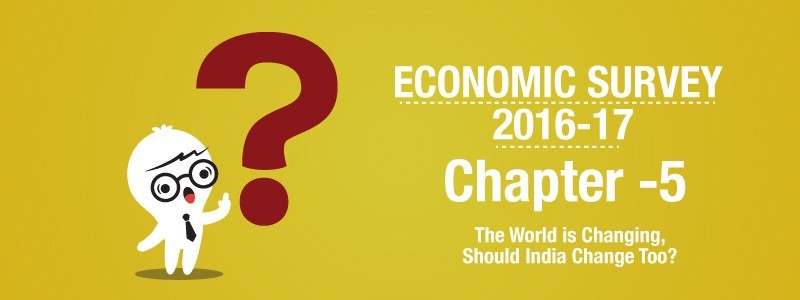Chapter-05 – Fiscal Framework: The World is Changing, Should India Change Too? – Highlights
Fiscal Framework: The World is Changing, Should India Change Too?
The Economic Survey 2016-17 is tabled in the parliament to mark the beginning of budget session. Here are the major highlights from the Chapter 5 of Economic Survey 2016-17.
Economic survey analyses the Fiscal Responsibility & Budgetary Management Act (FRBMA) in the light of increasing fiscal activism in advanced economies. Through the chapter in the Economic Survey 2016-17, one gets an outline of the 13 years since the Act came into existence and India’s fiscal position.
Why is there a need for active fiscal policy?
- Prevalence of weak economic activity (twin balance sheet problem, which is holding back investment and credit growth and hence overall economic activity).
- Inability to address this problem through monetary policy.
How Indian situation differs from other advanced economies?
- Indian growth rates are substantially higher, while inflation rates are also substantially greater. As a result, monetary policy is nowhere close to the zero lower bound, reducing the need for fiscal activism.
- Because inflation is already relatively high, counter-cyclical policy has to be much more sensitive to triggering higher inflation.
* A ‘countercyclical’ fiscal policy refers to the opposite approach: reducing spending and raising taxes during a boom period, and increasing spending/cutting taxes during a recession.
- India’s own recent experience – two episodes of Indian macro- vulnerability in the last 35 years—1991 and 2013—were associated with, even preceded by, large increases in fiscal deficits. The inability to rein in these deficits played a key role in undermining India’s external situation, which led to the balance of payments crisis of 1991.
- India’s debt-to-GDP ratio is higher than many other emerging markets.
*Debt-to-GDP ratio is the ratio between a country’s government debt (a cumulative amount) and its gross domestic product (GDP) (measured in years). A low debt-to-GDP ratio indicates an economy that produces and sells goods and services sufficient to pay back debts without incurring further debt.
The Economic Survey 2016-17 goes on in great length to discuss the deficits and Indian fragilities. The important observation in the survey is that,
India’s primary deficit, which is the shortfall between its receipts and its non-interest expenditures, is highly vulnerable. Put simply, India’s government (Centre and states combined) is not collecting enough revenue to cover its running costs, let alone the interest on its debt obligations.
Consequence of having a Primary deficit – The government is dependent on growth and favourable interest rates to contain the debt ratio.
The Economic Survey goes onto to mention the path for the future fiscal framework. India has become a middle-income country during the course of the 13 years since FRBM was enacted.
* Middle-income countries (MICs) are nations with a per-capita gross national income in 2012 between $1,036 and $12,615. Middle-income countries (MICs) are one of the income categories that the World Bank uses to classify economies for operational and analytical purposes.
Concluding remarks:
Advanced countries have moved away from prudent fiscal rules and principles toward greater fiscal activism, giving counter-cyclical policies much more of a role and giving correspondingly less weight toward curbing the debt stock.
But India’s experience has taught the opposite lessons. It has reaffirmed the need for rules to contain fiscal deficits, because of the proclivity to spend during booms and undertake stimulus during downturns. It has also highlighted the danger of relying on rapid growth rather than steady and gradual fiscal and primary balance adjustment. In short, it has underscored the fundamental validity of the fiscal policy principles set out in the FRBM.
The Economic Survey ends the chapter suggesting the need to modify the operational framework of FRBMA designed in 2003 to meet existing macro economic reality.
*N.K. Singh heads the FRBM Review Committee.
Also Read : Top 10 Key Highlights of Economic Survey 2016-17 for UPSC Aspirants
Also Read: Chapter wise highlights of Economic Survey 2016-17
Chapter 01 – Economic Outlook and Policy Challenges
Chapter 02 – The Economic Vision for Precocious, Cleavaged India
Chapter 03 – Demonetization: To Deify or Demonize?
Chapter 04 – The Festering Twin Balance Sheet Problem
Chapter-05 – Fiscal Framework: The World is Changing, Should India Change Too?
Chapter 06 – Fiscal Rules: Lessons from the States
Chapter 07 – Clothes and Shoes: Can India Reclaim Low Skill Manufacturing?
Chapter 08 – Review of Economic Developments
Chapter 09 – Universal Basic Income
Chapter 10 – Income, Health, and Fertility: Convergence Puzzles
Chapter 11 – One Economic India
Chapter 12 – India on the Move and Churning
Chapter 13 – The ‘Other Indias’ – Highlights of Economic Survey 2016-17
Chapter 14 – From Competitive Federalism to Competitive Sub-Federalism
Download PDF to your email
*/ ?>The Only Resource Needed To Crack The UPSC Prelims Test 2017
Monthly Current Affairs Archives

 Login
Login

![Salient features of Right to Information [RTI Act ] 2005](https://www.selflearn.co.in/wp-content/uploads/2017/07/SALIENT-FEATURES-OF-RIGHT-TO-INFORMATION-RTI-ACT-2005-FOR-CIVIL-SERVICES-IAS-EXAM-PREPARATION-1-81x66.jpg)
![Right to Information [ RTI Act ] 2005 -Historical Background](https://www.selflearn.co.in/wp-content/uploads/2017/07/RIGHT-TO-INFORMATION-RTI-ACT-2005-FOR-CIVIL-SERVICES-IAS-EXAM-PREPARATION-01-81x66.jpg)













